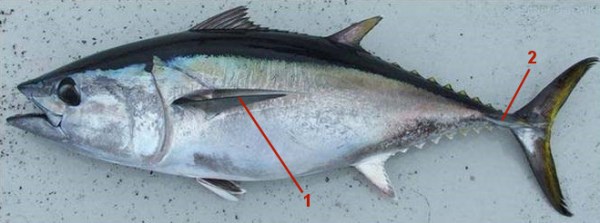
Unlike the canned variety at the supermarket with its convenient labels, it’s hard to tell the difference between some of the varying tuna species when you get one on your line. To make it a little trickier the pacific bluefin and the southern bluefin tuna are very similar at a glance.
Southern bluefin tuna have been making a strong appearance off the west coast of both the North and South Islands, including Fiordland.
Unlike the pacific bluefin, the southern bluefin tuna has a recreational daily limit of one fish per angler.
We recommend that when fishers catch tuna and aren’t sure which kind they’ve caught, they adopt the ‘one fish’ limit for southern bluefin. It’s better to be cautious rather than taking more fish and risking a fine.
Fisheries New Zealand monitors recreational harvest through reported catch (mostly from fishing club records), focussing on the areas where most fishing occurs. Recording or weighing your catch at a fishing club would ensure that it is accounted for in recreational catch estimates, which are vital to managing the fishery. If you haven’t reported your catch through a fishing club you can also report it online at fishcatch.co.nz.
Southern bluefin tuna (Thunnus maccoyii)
Pectoral fins (1) short, less than head length; top front of the body cavity has a prominent bulge (when gills and gut removed).
Coloration: dark blue back transitioning into lighter blue with dark fins; lower sides and belly mainly silver, faint vertical lines or dots fading on death; caudal keel (2) pale or yellow but may be darker in large fish. Attains 220 cm length and 165 kg in weight.
Pacific bluefin tuna (Thunnus orientalis)
Pectoral fins (1) short, less than head length; top front of the body cavity has a small narrow bulge (when gills and gut removed). New Zealand’s largest growing tuna attaining over 300 cm fork length and 400 kg weight.
Coloration: dark blue back transitioning into lighter blue with dark fins; may have spots on the head (2); 2nd dorsal fin (3) reddish-brown; caudal keel (4) at base of the tail dark; lower sides (5) and belly silver with consistent spots and faint vertical lines; anal fin (6) silver edged with black.

Keeping up-to-date with the recreational fishing rules for your area is easy with the NZ Fishing Rules app. Once downloaded the app can also be used offline. You can find out more about the rules and download the free NZ Fishing Rules app from mpi.govt.nz/fishing-rules












